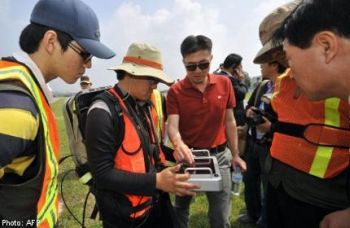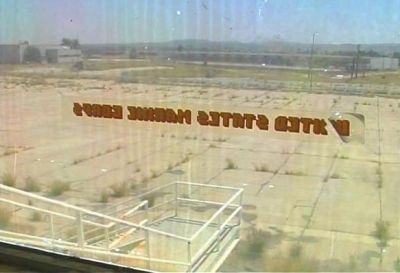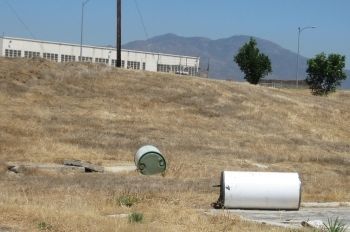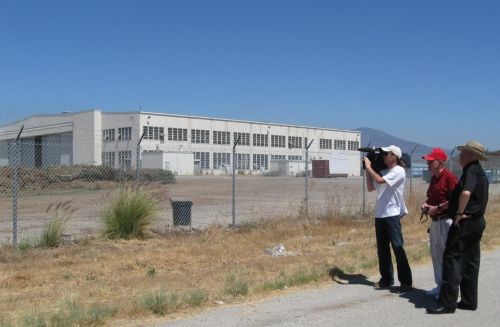
Publisher:
Bonnie King
CONTACT:
Newsroom@Salem-news.com
Advertising:
Adsales@Salem-news.com

~Truth~
~Justice~
~Peace~
TJP
Jul-15-2011 19:33

 TweetFollow @OregonNews
TweetFollow @OregonNews
Ground Penetrating Technology Used to Locate Agent Orange Drums
Robert O'Dowd Salem-News.comGround penetrating technology is being used to locate buried Agent Orange drums at Camp Carroll, Korea. The same technology could be used to find TCE/PCE drums buried at former MCAS El Toro.
 Photo Courtesy, The Korea Herald |
(IRVINE, Calif.) - The U.S. Army and the Korean government are using ground penetrating technology to locate hundreds of barrels of 55 gallon drums of Agent Orange and other chemicals at Camp Carroll, South Korea, according The Korea Herald.
The same technology can be used by the U.S. Navy, responsible for remediation at former MCAS El Toro, to locate the buried drums of TCE/PCE.
The 3rd Marine Aircraft Wing left for Miramar in July 1999. The former base was sold to a real estate joint venture in 2005. TCE was used as a degreaser for aircraft at the base for decades, resulting in a Trichloroethylene (TCE) plume spreading miles into Orange County.
El Toro was a Marine Corps base for 56 years. The base kept no TCE usage records but literally thousands of barrels of TCE may have been used over this time period.
TCE waste entered the soil, the groundwater, and the aquifer under the base and spread miles off base into the Orange County aquifer. Two agricultural wells off base and one on the base were found to be contaminated with TCE by the Orange County Water District (OCWD) in 1985. The TCE plume was traced back to El Toro.
 Looking out of a hangar at El Toro's MWSG 37 area, the base's |
The Navy reached a settlement with OCWD and the Irvine Ranch Water District (IRWD) in 2001 to provide $42 million in federal funds plus $7.2 million in contingency funds for groundwater clean-up and treatment of groundwater. In 2002, the Navy agreed to pay $27 million to help pay for a desalination plant. The Navy’s environmental remediation work is on-going in cooperation with OCWD and the Irvine Ranch Water District (IRWD).
Information from official government reports show that TCE chemicals were used even though their authorization was withdrawn and extraordinary methods were taken to hide the evidence from the Marine Corps Inspector General. Instead of waiting for the steel drums to rot or miraculously appear on the surface, the Navy could follow the example of the U.S. Army at Camp Carroll, South Korea.
The U.S. Army and the Korean government are using ground penetrating technology to locate hundred of buried drums of Agent Orange and other chemicals at Camp Carroll in South Korea. The joint task force used a process called “Electrical Resistivity” to locate and map abnormalities underground.
Lee Sun-Young, reporter for The Korea Herald, broke story on July 9, 2011 on the use of ground penetrating technology to locate the buried AO drums.

According to Sun-Young, “A joint Korea-US investigation team found signs that metallic objects, shaped like drums, may be buried underground at one of the US military camps in Korea…the will now take samples of soil from as far as 10 meters deep to verify a claim by US veteran Steve House that he helped bury hundreds of drums believed to contain Agent Orange near a helipad in Camp Carroll…geophysical surveys of the helipad area found some anomaly.” The joint task force is co-chaired by OK Gon, professor at Bookyung University and Colonel Joseph F. Birchmeier, U.S. Army.
Mr. Don Zweifel, Restoration Advisory Board (RAB) member, reported to the Navy way back on July 27, 2005 during public comments on “El Toro’s Draft Record of Decision for Site 24, the Volatile Organic Solvent (VOC) Source Area” that former El Toro employees told him of the practice of burying drums of contaminants on the base.
No records were maintained of where the barrels were buried and the Navy’s official response was no remediation efforts would be undertaken unless the buried barrels were found. Barring a miracle, it’s unlikely that the barrels will spontaneously appear on the ground surface. Over time, the steel 55 gallons drums will rot and the toxic contaminants will be released into the soil.
Although this could be a tedious effort, the military has the means of detecting buried metal containers. Although not suggested by Mr. Zweifel, a search of the 4,000 acres property by the military could locate the buried drums. Once found, the drums could be removed and properly disposed of.
Why wait for the drums to rot and endanger children and others? A proactive remediation approach would avoid injuries from rotting containers spilling their contents into the ground.
Review showed that the Navy ignored Zweifel’s concerns about the need to find the barrels, citing their policy, “The Department of the Navy (DON) also has a comeback policy that states the circumstances under which the DON will return to perform additional cleanup. One of those circumstances is the subsequent discovery of additional contamination attributable to DON activities. This would allow for additional investigation if buried barrels of contaminants where found anywhere on Former MCAS El Toro property in the future.”
COMMENTS FROM MR. ZWEIFEL, EL TORO RAB MEMBER
“You know, I remember some comments from the employees at MCAS El Toro that told me they buried barrels of contaminants. And why did they do it? I don’t know if that’s important right now. I can tell you later about why they did it – but actually it had to do with the – if it was a half-filled barrel of PCE, they had to remove that barrel because they wouldn’t get a full barrel or – barrels of PCE [TCE was the primary VOC but PCE may have been used as a degreasing agent, too] is vital for cleaning aircraft, they had to have it.
 Shot of barrels in the 37 area at El Toro. Contents |
The thing is, I’m saying, there are probably barrels buried down here and they are sealed and they are coated, but the thing is, eventually you’ve got to face it, those barrels are going to leak. They will leak. Maybe they haven’t leaked yet, but they eventually will leak.”
Miller Jackson, who was in charge with the physical plant at El Toro years ago, said he knew what they did. When the MG inspection was about to come, they buried them, but he didn’t say where. I don’t know if he is alive anymore. I talked to him ten years ago about this. And remember, Andy, I told you about this. And, Content, I already mentioned it to her, most of you guys know. I am just reiterating an old song. The thing is, ladies and gentlemen, this is a great concern to me. What is going to happen to those barrels? Right now it appears everything is okay, but the thing is, I think those barrels will eventually leak.”
“I don’t know how many of them there are, but I am almost sure there are some barrels there. So what I am proposing, if I may, is that continued monitoring of Site 24 on the periphery, down gradient mind you, for, I don’t know, maybe, five, ten, 15, 20 years maybe. Because it will take a while for those barrels to leak, especially if they are coated. And most of the barrels were. And you may say, “Well, how long is it going to take to erode a steel barrel?”
Who knows? It’s hard to say. But I’m saying that eventually those barrels will leak. We tentatively or at least potentially think they are there, that’s why I’m proposing – I’m sorry, you’re going to have to monitor this site for years and years to come to make sure that those barrels, that are probably there, don’t leak. And if they do leak, then you’re going to have to come back and – see I’m worried about the City of Irvine and Lennar and – because you’re going – I mean restrictive covenants on this site, until you can guarantee that.
 Tim King, Robert O'Dowd and John Uldrich; all former El Toro Marines, all |
If you want to sign off on this and say, “There is not going to be any more contamination from this site. You can go ahead. Well, that’s great, but your neck should be on the line. And if they find that these barrels have leaked, if they are truly there, well, then you are going to have to come back, the Navy is going to have to come back and solve that problem. And you’re going to have to promise that – the Department of the Navy is going to have to promise us that they are not going to leak. And if they do, you are going to have to come back and remediate.”
The official response from the Navy was that additional investigations would be undertaken if “buried barrels of contaminants were found anywhere on former MCAS El Toro property in the future.”
The Navy’s response addresses the studies done in regard to Site 24, a 200 acres mostly paved or asphalted area. One problem is that El Toro’s employee may not have used this area to bury TCE drums. It would have much easier to bury the drums in unpaved areas using a front end loader or other equipment to dig. Most of Site 24 located in the Southwest quadrant of the former base is paved. Unpaved areas in unpopulated portions of the base or even one or more of the landfills (no digging required) would be more likely areas to bury TCE drums.
In any case, waiting for barrels of toxic chemicals to rot before removing them does not appear to is a responsible policy, especially when the area may be a route of exposure of toxins to children and others using recreational facilities on the former base.
Instead of waiting for the steel drums to rot or miraculously appear on the surface, the Navy, responsible for the remediation at El Toro, could follow the example of the U.S. Army in South Korea.
Will the Navy pursue the use of this technology at former MCAS El Toro to locate the buried drums of TCE/PCE? The former base was comprised of 4,700 acres. Surfaces paved with concrete or macadam for decades can immediately be eliminated from any survey, but that still leaves acres of open ground. The Navy has the engineering talent to conduct a survey following the U.S Army example in Korea but without human intelligence of the locations where drums were buried, the costs may deter any Navy attempts to locate them.
Pressure could be applied by the El Toro RAB, the city of Irvine, and Heritage Fields LLC, a joint venture between developer Lennar Corporation and several other firms, who purchased 3,724 acres from the Navy in 2005.
More on the story of former MCAS El Toro can be read in A Few Good Men, Too Many Chemicals, a book on the environmental contamination at former MCAS El Toro and Camp Lejeune, North Carolina, co-authored by Tim King and Robert O’Dowd, published in the Fall 2011 by MilSpeak Books, an eBook press featuring the works of military personnel.
 Bob O’Dowd is a former U.S. Marine with thirty years of experience on the east coast as an auditor, accountant, and financial manager with the Federal government. Half of that time was spent with the Defense Logistics Agency in Philadelphia. Originally from Pennsylvania, he enlisted in the Marine Corps at age 19, served in the 1st, 3rd, and 4th Marine Aircraft Wings in 52 months of active duty in the 1960s. A graduate of Temple University, Bob has been married to Grace for 31 years. He is the father of two adult children and the grandfather of two boys. Bob has a blog site on former MCAS El Toro at mwsg37.com. This subject is where Bob intersected with Salem-News.com. Bob served in the exact same Marine Aviation Squadron that Salem-News founder Tim King served in, twenty years earlier. With their combined on-site knowledge and research ability, Bob and Tim and a handful of other ex-Marines, have put the contamination of MCAS El Toro on the map. The base is highly contaminated with TCE, trichloroethelyne
Bob O’Dowd is a former U.S. Marine with thirty years of experience on the east coast as an auditor, accountant, and financial manager with the Federal government. Half of that time was spent with the Defense Logistics Agency in Philadelphia. Originally from Pennsylvania, he enlisted in the Marine Corps at age 19, served in the 1st, 3rd, and 4th Marine Aircraft Wings in 52 months of active duty in the 1960s. A graduate of Temple University, Bob has been married to Grace for 31 years. He is the father of two adult children and the grandfather of two boys. Bob has a blog site on former MCAS El Toro at mwsg37.com. This subject is where Bob intersected with Salem-News.com. Bob served in the exact same Marine Aviation Squadron that Salem-News founder Tim King served in, twenty years earlier. With their combined on-site knowledge and research ability, Bob and Tim and a handful of other ex-Marines, have put the contamination of MCAS El Toro on the map. The base is highly contaminated with TCE, trichloroethelyne
You can email Bob O’Dowd, Salem-News.com Environmental and Military Reporter, at this address: consults03@comcast.net
Articles for July 14, 2011 | Articles for July 15, 2011 | Articles for July 16, 2011



googlec507860f6901db00.html


Terms of Service | Privacy Policy
All comments and messages are approved by people and self promotional links or unacceptable comments are denied.
D.C. Wright USMC Retired September 16, 2011 5:16 pm (Pacific time)
Hmmm... I was at El Toro '72-'74. Is the VA on this yet? Between Lejeune and El Toro, they've got a LOT of us to worry about. Especially the majority of us who were bi-coastal back then. I was at Geiger for ITR in '67, then New River for duty after my "A" school. Kinda makes me wonder!
Editor: Interesting, the truth is that El Toro is not on any lists, though it is an EPA Superfund site. With Obama doing what he is doing, we have a long way to go. Robert O'Dowd and I have a new book due out very soon, it tells much of this, and there are many other stories here recounting the story on Salem-News.com.. You can always write to us, there are 14 current and former Marines writing for us, we have email listed on our staff page, my name is Tim King. Semper fi.
Jim July 16, 2011 2:31 pm (Pacific time)
Are there TCE/PCE drums buried at Camp Lejeune? I would say yes, They needed an East Coast dump???? That would be Camp Lejeuene.
[Return to Top]©2026 Salem-News.com. All opinions expressed in this article are those of the author and do not necessarily reflect those of Salem-News.com.